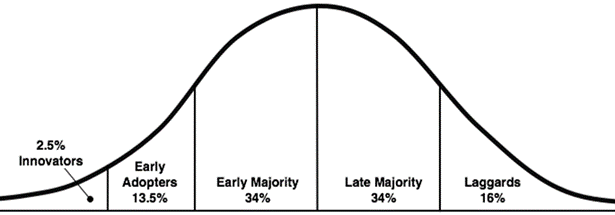Table of Contents
Diffusion of Innovation (DOI) Theory
One of the earliest social science theories is the Diffusion of Innovation (DOI) Theory, which was created by E.M. Rogers in 1962. It first appeared in communication to describe how an idea or product gradually gathers steam and diffuses (or spreads) within a particular population or social system. People eventually adopt a new idea, habit, or product as a component of a social system as a result of this dissemination. Adoption is the act of doing something different from what was done previously (i.e., purchase or use a new product, acquire, and perform a new behavior, etc.). Adoption depends on the person thinking the concept, action, or product is novel or inventive. Diffusion is facilitated through this process.
The process through which certain people are more likely to accept the invention than others rather than happening simultaneously in a social system is known as “innovation adoption.” According to research, those who adopt innovations sooner than those who acquire them later have different traits. Understanding the traits of the target audience that will facilitate or impede the adoption of the innovation is crucial when promoting innovation to that group. Although the bulk of the general population tends to fall towards the middle of the five recognized adopter categories, it is still important to comprehend the traits of the target demographic. Diverse strategies are employed while promoting an innovation to appeal to the various adopter categories.
- Innovators – These are those that desire to try an invention first. They are bold and curious about novel concepts. These folks are frequently the first to come up with novel ideas and are very eager to take chances. If anything, not much has to be done to appeal to this demographic.
- Early Adopters – These are the opinion leaders who make up this group. They like taking on leadership responsibilities and embracing change. They are quite at ease implementing new concepts because they are already conscious of the need for change. How-to guides and implementation information sheets are two tactics to appeal to this demographic. Information is not necessary to persuade this group to change.
- Early Majority – Although they hardly ever take the lead, this group is the first to adopt novel concepts. Having said that, before they are willing to adopt an innovation, they often require proof that it is effective. Success stories and proof of the innovation’s efficacy are some strategies to appeal to this demographic.
- Late Majority – These people are resistant to innovation and wait until the majority has adopted it before embracing it. Information on how many other individuals have tried the innovation and successfully adopted it is one tactic to appeal to this audience.
- Laggards – These individuals are extremely conservative and tradition-bound. They are the hardest group to convince to accept change since they are so resistant to it. Statistics, fear appeals, and peer influence from other adopter groups are all methods for influencing this population.

Source: http://blog.leanmonitor.com/early-adopters-allies-launching-product/
Innovation Adoption Influencers
Awareness of the need for an innovation, choosing to adopt (or reject) the innovation, using the innovation initially to test it, and ongoing use are the stages by which a person adopts an innovation and whereby dissemination is accomplished. The adoption of an innovation is influenced by five key elements, each of which is present in the five adopter categories.
- Relative Advantage – How much an innovation is thought to be superior to the concept, system, or product it replaces.
- Compatibility – How consistent the innovation is with the requirements, values, and experiences of potential adopters.
- Complexity – How challenging it is to comprehend and/or use the innovation.
- Triability – The degree to which the idea can be tried out or tested out before being decided to be adopted.
- Observability – The innovation’s ability to provide measurable results.
Limitations of Diffusion of Innovation
The diffusion of innovation has a number of drawbacks, including the following:
- The adopter categories originate from the public sector; they weren’t specifically created to relate to the adoption of new behaviors in government. Governmental organizations frequently fall into the laggard category when it comes to innovation.
- It fails to promote a participatory adoption process.
- It works better with behavior adoption than behavior cessation or prevention.
- It ignores an individual’s resources or social support to adopt the new product, behavior, or innovation.
Source: Boston University
